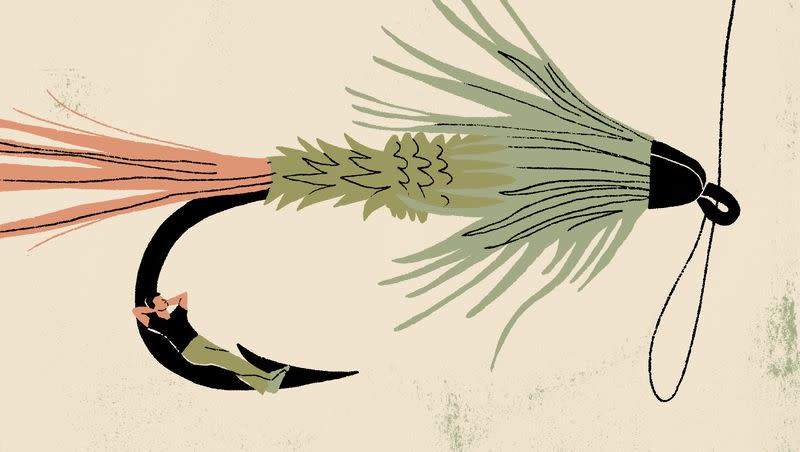Fly-fishing — the most complicated hobby in the world?

- Oops!Something went wrong.Please try again later.
“Angler” is as broad a term as you can get. It describes my grandfather, who stuck a rod in the sand and fell asleep while bass pilfered PowerBait off his hook. It also describes Norman Maclean, author of the novella “A River Runs Through It,” who wrote, “It is really fishermen who experience eternity compressed into a moment.”
I’m not saying one approach is better than the other, but for a kid growing up in the Rockies, fly-fishing possessed a kind of romantic glow that could not be matched by bait fishing. It’s that snappy little whip of a cast that turned my head. It’s walking around in a river in your waterproof waders, but not getting wet (the same feeling that makes waterbeds the ultimate sleeping platform). It’s being so attuned to the stream that fish can’t tell where bugs end and your fluffy little fake fly begins.
This summer, knowing absolutely nothing about fishing, I got serious about my fishing game. I wanted to feel eternity dripping down my elbow as I pulled a rainbow trout from the streams of time. “Enough of this indoor living,” I told myself. “I’m gonna be a water boy.”
I was in the right place. Utah is home to some of the best fly-fishing in the country (so I’ve heard). The Green River and the Provo River top the list, containing almost too many trout species to count. That could be cool if I knew the difference between a brookie and a rainbow. But I was hungry for that fish. For that lifestyle.
The preliminary research should have warned me that fly-fishing is complicated. Really complicated. My only experience with fish involve my pet betta, the aquariums at Scheels and my grandmother’s baked salmon.
I had to find a mentor, a professor of fish knowledge. So I reached out to a local man on the KSL classifieds who orders fishing equipment in bulk from China and sells it out of his garage. He set me up with a fishing pole. It had numbers on the side, a cipher containing all the characteristics of the rod — weight, flexibility, maybe snappiness or grabbiness, maybe length. I don’t know.
Related
His workbench was covered with boxes of fake flies. Another vital part of fly-fishing I knew nothing about.
There is a guiding phrase in all this: “Match the hatch.” Matching the hatch requires a regular guy like me to understand which bugs are hatching on which specific bodies of water during the times of the year I plan on fishing.
So I stood there, looking at these little hand-tied bugs on a workbench. I was told half are tied by a guy in Kenya. I don’t ask how a guy in Kenya knows what’s hatching on the Strawberry Reservoir in July. I don’t care.
My fish professor tried explaining what I was seeing. I heard the words he was using, but they meant nothing to me. I don’t know what a No. 20 Zebra Midge is, I don’t know how to use 4x tippet (which is some kind of fishing line) to make dropper rig out of a No. 16 Prince nymph.
I felt like I was listening to the undecipherable commentary on freestyle skateboarding tricks at the X Games: Kickflips, Ollies, Who Dunnits.
Here I was, rod in one hand, a little box of flies in the other. But there was still more gear to acquire. Snippers and clippers and pinchers and nets and wet pants and dry bags. All this for a fish. A fish that you will catch, brag about and release.
Back at home, I sat and watched hours of videos on the types of knots, as wide in variety as species of trout in the Logan River, and put my rod in order. But there was still the issue of that magic cast. A cast, as Maclean put it, that was “so soft and slow that it can be followed like an ash settling from a fireplace chimney.”
I’ve seen anglers in my local park, in a wide field on a sunny day, practicing their cast. Back and forth for hours as the dogs in the shade follow the motion of the rods with their heads. Back and forth. “That’s cool, I guess,” I thought to myself. “I’d rather learn on the job.”
Related
So I planned a trip to the South Slope of the Uinta Mountains, hoping to catch some cutthroat to roast over my coals. I hiked up into the solitude of pristine alpine lakes. It was drizzling, and my cast fell about five feet in front of me, sometimes five feet behind me. Eternity is swishing and slapping your little fishing pole around for hours without the slightest hope a fish will mistake your fly for a flake of ash settling on the water, or an actual fly that looks yummy.
I realized I was unprepared. I had overlooked a couple dozen details that are vital to the beguiling of fish. Despite clawing my way up the learning curve, I did not deserve to call myself an angler.
But then the sun set behind Mount Emmons, and the water grew still and glassy. The lake was a mirror reflecting blushing clouds and the silhouettes of pine trees. I stood there in silence, listening to the evening calls of a dove or grebe or something. I don’t know, some kind of bird. I stood very still, watching the dark ripples of trout nibbling at real bugs, and this whole fishing thing became very simple.

